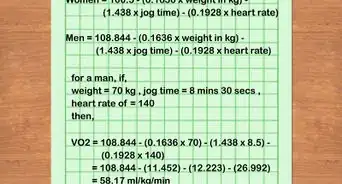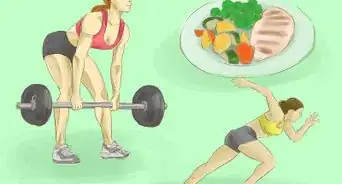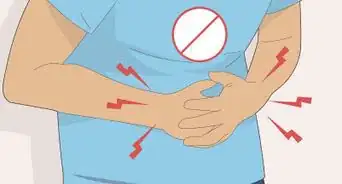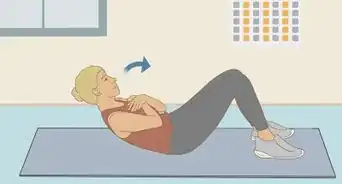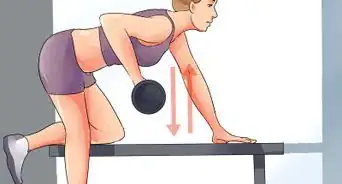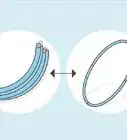This article was co-authored by wikiHow Staff. Our trained team of editors and researchers validate articles for accuracy and comprehensiveness. wikiHow's Content Management Team carefully monitors the work from our editorial staff to ensure that each article is backed by trusted research and meets our high quality standards.
wikiHow marks an article as reader-approved once it receives enough positive feedback. In this case, 95% of readers who voted found the article helpful, earning it our reader-approved status.
This article has been viewed 184,184 times.
Learn more...
Hula Hooping is a great way to have fun and stay fit. There are so many different varieties of hooping from hoop dance to fitness hooping. Are you interested in trying it out, but don’t know exactly what type of hula hoop to choose? The best way to decide on the right hula hoop is to take into consideration a number of factors including the size, weight, and style. Happy hooping!
Steps
Deciding on the Right Size of Hula Hoop
-
1Measure your height from the floor to your belly button. This measurement will then help to determine the diameter of the hoop you should purchase. The hula hoop, when resting vertically on the ground, should reach somewhere between your waist and mid-chest. This is your base diameter measurement and can be adjusted slightly depending on your size and experience level. [1]
- For example, most adults will begin with a hula hoop between 40 and 44 inches in diameter.
-
2Factor in your body type. If you are smaller than average you can take 2–4 inches (5.1–10 cm) off of the diameter determined by your height. Similarly, if you are larger than average you should add 2–4 inches (5.1–10 cm) to the diameter determined as a result of the previous step.Advertisement
-
3Experienced hula hoopers can choose a smaller hoop. If you are an experienced hula hooper you should use a smaller hoop. Similarly if you have a background in dance or are in good shape you can likely start with a slightly smaller hoop.
- For example, experienced hula hoopers can take 2–3 inches (5.1–7.6 cm) off of the diameter size determined by their height.
- If you are having trouble keeping the hoop up for at least 5-10 seconds then it is likely too small and you should use a larger hoop.
Taking into Account the Weight and Material of the Hula Hoop
-
1Decide on a heavier hoop if you are a beginner. Hula hoops that are larger and heavier are great for beginners because the added weight gives the hoop more momentum as it moves around you making it easier to keep the hoop up. [2]
- Heavier hoops are also suggested if you are learning a new skill or trick.
-
2Use a light hula hoop if you are short. If you are under 5 foot 4 inches (10.2 cm) and relatively slim you will want to find a lighter hoop with a smaller tubing diameter. A smaller tubing diameter will make it easier for you to grip the hoop with your hands. A lighter hoop will also be easier to maneuver for a person with a small frame.
-
3Pick a hula hoop that has grips or add grips yourself. A hula hoop without grips can be slippery and difficult to keep up even for someone who is experienced. Purchasing a hula hoop with grips will allow you to have fuller contact with the hoop. Grips should be placed along the inner ring of the hoop to be the most effective. You can also wrap grips around the hoop to allow for fuller contact. Types of grips include:
- Sandpaper: use 100 grit or 80 grit sandpaper around the inner tubing, and add grooves into the hoop, which gives more texture for your hands, clothes, and body to connect with.
- Griptape: is twisted around the hoop and comes in a variety of colors.
- Hoop wax: is translucent and rubbed onto the hoop in the desired area. It is very sticky.
Picking a Hula Hoop Based on Your Desired Activity
-
1Light hula hoops are best for hoop dance and fitness hooping. If you are interested in using your hula hoop for hoop dancing a lighter and smaller hoop is best for you. Similarly, you burn the most calories by moving a lot while hooping and working your entire body. [3]
- A heavy hoop can be hard on your joints, especially when completing complex arm maneuvers.
- Heavier hoops could also cause injury or break something in the room if it spins off your arm.
-
2Get a variety of hula hoops to meet all your needs. It is often a good idea to have multiple different hula hoops in different sizes and weights. This way as you progress you can switch between hula hoops based on the activity you are completing. At times you may want to use a light and small hoop to complete complex tricks while at other times you may want a larger hoop for a longer workout. [4]
- Also, by having more than one hoop you can share with friends!
-
3LED and fire hoops are also an option for those who want to take hula hooping to the next level. If you have mastered the regular hula hoop and are looking for a new challenge or want to try your hand at the performance arts LED and fire hoops are available for purchase. There are many online retailers that make and sell fire hoops.
- It is a good idea to buy these hula hoops in a slightly smaller size than normal and to practice extensively with them before igniting. They will have a different feel from your normal hoops.
- Fire hoops also have an added wick that sticks out from the hoop to keep the fire a safe distance from the person using the hoop. As a result, you will need a larger space to practice.
Community Q&A
-
QuestionHow do you ensure the hula hoop does not fall?
 Community AnswerIf you are struggling to get the hula hoop to stay up, you may be using a hula hoop that is too small. Try using a larger and heavier hula hoop suitable for a beginner. If that does not work, try reading
Community AnswerIf you are struggling to get the hula hoop to stay up, you may be using a hula hoop that is too small. Try using a larger and heavier hula hoop suitable for a beginner. If that does not work, try reading -
QuestionI'm 4ft 11inches. What size hoop would I need?
 Community AnswerStart by holding your hula hoop vertically. It should reach somewhere between your waist and mid-chest. Alternately you can try measuring the distance between the floor and your belly button. This should be the diameter of your hula hoop.
Community AnswerStart by holding your hula hoop vertically. It should reach somewhere between your waist and mid-chest. Alternately you can try measuring the distance between the floor and your belly button. This should be the diameter of your hula hoop. -
QuestionWhat do I do if the hoop is too small?
 Community AnswerIf you are using a hula hoop that is too small you will find that you need to make very quick movements in order to keep the hula hoop going. Small hula hoops are typically for advanced hula hoopers. It would be best to use a larger hula hoop until you have mastered the basic skills.
Community AnswerIf you are using a hula hoop that is too small you will find that you need to make very quick movements in order to keep the hula hoop going. Small hula hoops are typically for advanced hula hoopers. It would be best to use a larger hula hoop until you have mastered the basic skills.
Things You'll Need
- Hula hoop
References
- ↑ http://hooplovers.tv/what-size-hula-hoop-should-i-buy-for-beginners/
- ↑ https://www.mayoclinic.org/healthy-lifestyle/fitness/expert-answers/weighted-hula-hoops/faq-20058073
- ↑ http://hooplovers.tv/what-size-hula-hoop-should-i-buy-for-beginners/
- ↑ http://hooplovers.tv/what-size-hula-hoop-should-i-buy-for-beginners/
About This Article
Hula hooping is a great way to have fun and stay fit, but you’ll want to choose one that fits your body and needs the best. When the hula hoop is upright on the ground, it should reach somewhere between your waist and mid-chest. If you’re an experienced hula hooper, you can pick a smaller hoop, but if you have trouble keeping it going, chances are it’s too small. Beginners will want a heavier hoop since the weight will help give it more momentum, but if you’re on the shorter side, then opt for a lighter hoop. Lighter hoops are also best for hoop dance and fitness hooping. To learn how to pick the best hula hoop for doing tricks, keep reading!
-Step-1-Version-3.webp)
-Step-2-Version-3.webp)
-Step-3-Version-2.webp)
-Step-4-Version-3.webp)
-Step-5.webp)
-Step-6.webp)
-Step-7.webp)
-Step-8.webp)
-Step-9.webp)



